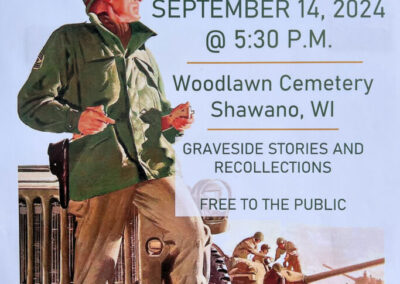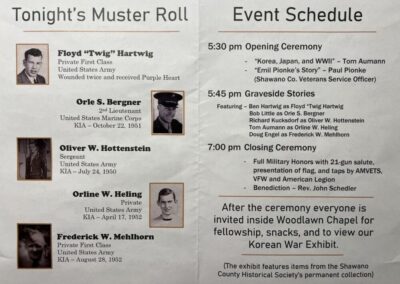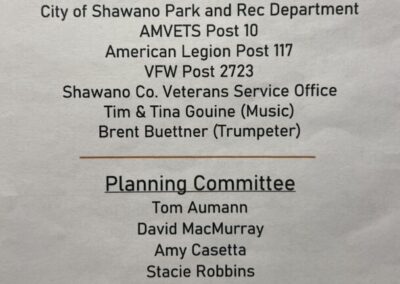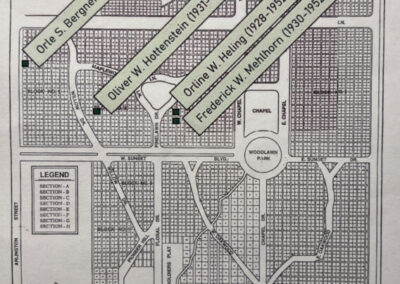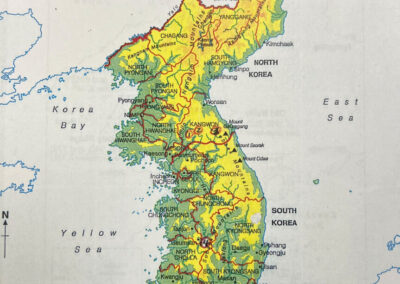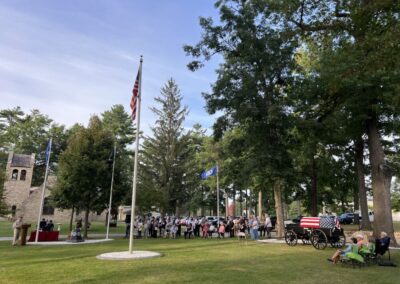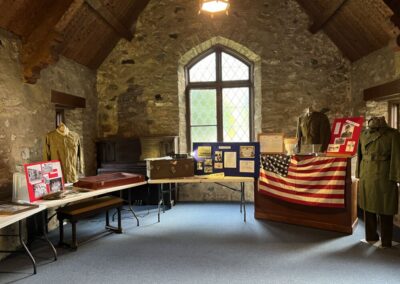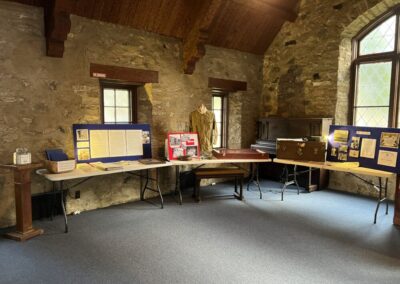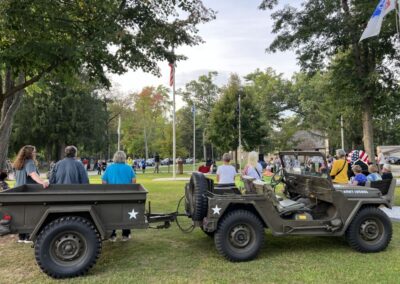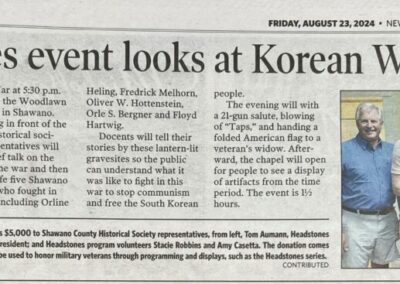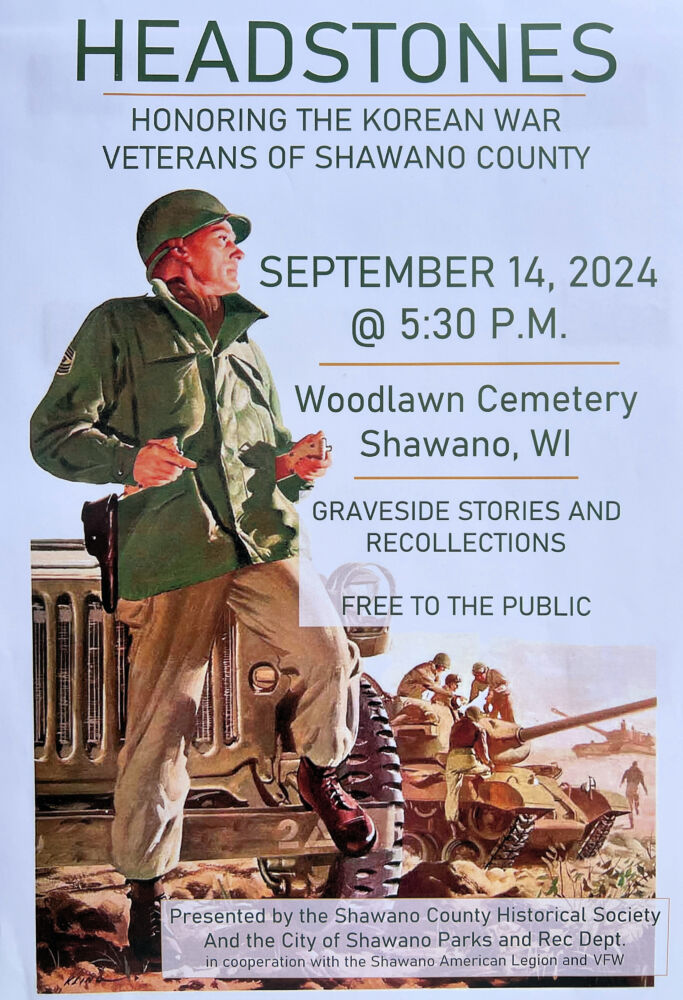
Photo Gallery
Our Korean War Heroes
SHAWANO COUNTY HISTORICAL SOCIETY AND SHAWANO PARK & REC PRESENT:
HEADSTONES Korean War
HONORING OUR Korean War VETERANS
The Shawano County Historical Society and the City of Shawano Parks and Rec Department in cooperation with the Shawano American Legion, VFW, and AMVETS, will be presenting another program in the Headstones Series on the Shawano veterans of the Korean War at the Woodlawn Cemetery in Shawano at 5:30 pm on Saturday, September 14, 2024.
Starting at 5:30 in front of the chapel, we will give a brief talk on the cause of the war and then bring to life five Shawano veterans who fought in that war:
Orline Heling, kia 4/20/53
Fredrick Melhorn, kia 8/29/1952
Oliver W. Hottenstein, kia 7/24/50
Orle S. Bergner, WWII and Korea, kia 10/22/51
Floyd Hartwig, wounded in action but made it home to enjoy a full life in Shawano.
Docents will tell their stories by these lantern-lit gravesites so the public can understand what it was like to fight in this war to stop communism and free the South Korean people.
We will end the evening with a 21-gun salute, blowing of taps, and handing a folded American flag to a kia veteran’s widow. Afterward, come into the chapel to see a display of artifacts from the time period. Total time for the event is approximately an hour and a half. Come join us and learn another part of Shawano County’s past!
Korean War timline
June 25, 1950 – North Korea Invades South Korea Inu
February 28, 1950 – Seoul Falls to North Korea
July 1, 1950 – US troops arrive
July 5, 1950-Task Force Smith at Battle of Osan
Aug 4 through Sep 18, 1950 – Battle of Pusan Perimeter
September 15-19, 1950 – Inchon landing
September 28, 1950 – Seoul recaptured by South Korea
October 7, 1950 – United Nations pushes North Korea back to the 38th parallel. The war was over but UN decides to attack North Korea in an attempt to unify both countries into one Korea.
October 12, 1950 – UN captures Pyongyang
October 25, 1950 – China enters the war (400,000 troops)
November 25, 1950 – Chinese attack – Battle of Chosin Reservoir
December 13, 1950 – Battle of Chosin Reservoir ends
December 31 – January 7, 1951 – Chinese take Seoul
March 15,1951 – UN recaptures Seoul
April 1951 – General Macarthur fired
June 1951 – Jul 1953 – Stalemate – Battles on 38th parallel
July 1951 – Peace talks begin
July 27, 1953 – Armistice signed
Outbreak of the War
The Korean War began with a surprise attack June 25, 1950, when eight divisions and an armored brigade (90,000 soldiers) of the North Korean People’s Army (NKPA) attacked in three columns across the 38th parallel and invaded the Republic of Korea (ROK). Many of the NKPA were battle-tested, having served in the Chinese and Soviet armies in World War II. The 98,000-strong ROK Army (ROKA), its combat training incomplete, and having no tanks and only 89 howitzers, was no match for the better-equipped NKPA. Aided only by a 500-man U.S. Korean Military Advisory Group, the ROKA was overwhelmed. Spearheaded by tanks, NKPA forces moved rapidly through the Uijongbu Gap on the west side of the Korean peninsula and captured Seoul, South Korea’s capital.
The ROKA fled south in disarray across the Han River toward Pusan, a major port at the southeastern tip of the Korean peninsula. On June 25, the U.N. Security Council denounced North Korea’s actions and called for a cessation of hostilities and withdrawal of the NKPA to the 38th parallel. President Harry S. Truman directed General of the Army Douglas MacArthur, whose Far East Command (FEC) was located in Tokyo, to evacuate American dependents from Korea and send ammunition to the beleaguered ROKA. The following day, Truman sanctioned the use of American air and naval forces below the 38th parallel. The next day, as the situation worsened, the United Nations requested its members to furnish military assistance to repel the invasion. Truman then extended American air and naval actions to North Korea and authorized the use of U.S. Army troops to protect Pusan. MacArthur, however, recommended committing a U.S. Army regiment in the Seoul area. Truman agreed, and on June 30 he told MacArthur to use all forces available to him.
South to the Naktong
Ground forces most readily available to MacArthur included the 1st Cavalry Division and the 7th, 24th and 25th Infantry Divisions, all under the Eighth U.S. Army (EUSA) headquartered in Japan; the 29th Regimental Combat Team (RCT) in Okinawa, Japan; and the 5th RCT from Hawaii. But these units were hard pressed to defend the ROK because they were undermanned, and their mobility and firepower had been reduced by shortages of organic units and equipment.
In an effort to delay the NKPA advance, MacArthur ordered the 1st Battalion, 21st Infantry Regiment of the 24th Infantry Division moved to a defensive position astride the main road near Osan, 10 miles below Suwon. Named Task Force (TF) Smith after the battalion commander, this 540-man command lacked effective anti-tank weapons and was ill-prepared to stop the NKPA. Outflanked by an NKPA division and suffering some 200 casualties and the loss of all equipment, TF Smith broke into a disorganized retreat.
Meanwhile, at the United Nation’s request, the United States formed the United Nations Command (UNC), which would integrate all American and allied forces. General MacArthur became its commander. He assigned command of ground forces in the Korea to Eighth U.S. Army under Lieutenant General Walton H. Walker. At the request of ROK President Syngman Rhee, Walker also assumed command of the ROK Army.
By the beginning of August, after the arrival of the 29th RCT from Okinawa on July 26,
Eighth U.S. Army held only a small portion of southeastern Korea. Walker ordered a stand along a 140-mile line arching from the Korea Strait to the East Sea (Sea of Japan) west and north of Pusan. Known as the “Pusan Perimeter,” American divisions occupied the western segment, basing their position along the Naktong River; the ROK Army defended the northern segment. With Pusan secure, additional troops and equipment began arriving to reinforce EUSA’s perilously long, thin defensive line. At the same time the arrival of the U.S. Army’s 5th RCT from Hawaii, the 2d Infantry Division and the 1st Provisional Marine Brigade from the United States, and a British infantry brigade, strengthened EUSA.
Inchon
Having traded space for time, MacArthur saw that the deeper the NKPA drove south, the more vulnerable it became to an amphibious envelopment. The amphibious force consisted of the 1st Marine Division and the 7th Infantry Division; its ranks fleshed out with several thousand Korean recruits. MacArthur’s decision to land at Inchon was a dangerous but remarkably bold and successful gamble. Tidal conditions allowed only a small window of opportunity for the landing. Moreover, he would be committing his last major reserves at a time when no more general reserve units were available in the United States.
Following the successful, lightly opposed landings at Inchon on Sept. 15, arduous street-to-street combat took place to liberate Seoul. On Sept. 29, the capital city was returned to President Rhee. Although many communist guerillas would remain behind, the NKPA virtually disintegrated and ceased to be an effective fighting force.
North to the Yalu
Truman authorized MacArthur to send his forces north of the 38th parallel on Sept. 27, provided there was no indication that major Soviet or Chinese Communist Forces (CCF) would enter the war. The U.N. General Assembly approved the UNC’s entry into North Korea 10 days later, when it called for the restoration of peace and security throughout Korea. American and ROK Army forces rapidly advanced northward.
Warnings of Chinese intervention increased as the UNC pressed deeper into North Korea. At a Wake Island meeting on Oct. 15, Truman directed MacArthur to continue his advance if he believed UNC forces had a reasonable chance of success. Hoping to end operations before the onset of winter, MacArthur ordered all ground forces to advance to the northern border as rapidly as possible.
The New War
Beginning on Oct. 25, UNC forces met stout resistance almost everywhere across their front. On November 1, the 1st Cavalry Division’s 8th Cavalry Regiment fought fierce battles with the CCF. Severe fighting continued Nov. 5–6, after which the CCF abruptly halted its activities in all sectors, leaving the UNC uncertain as to whether the CCF’s actions had been merely defensive.
Tenth Corps, reinforced by the U.S. 3d Infantry Division, and EUSA slowly renewed their offensive. Thinning logistical lines of support, inadequate intelligence and sub-zero cold added to the difficulties of the UNC. With the 7th Division leading, X Corps reached the Yalu at the town of Hyesanjin. Eighth Army units began moving forward from the Chongchon on Nov. 24, and were hit hard by strong CCF attacks. On Nov. 27, the attacks engulfed the leftmost forces of the X Corps at the Changjin (Chosin) Reservoir, and by Nov. 28th, UNC positions began to crumble. MacArthur informed Washington that the UNC faced an entirely new war. With more than 300,000 Chinese in North Korea, he directed Walker to withdraw to escape envelopment by the CCF. MacArthur ordered X Corps to fall back to a beachhead around the port of Hungnam.
Unrelenting CCF pressure, which often included surprise nighttime assaults and hand-to-hand combat and the rigors of a harsh winter, made the UNC’s retreat dangerous and costly. The 2d Division, covering the withdrawal of I Corps and the ROK II Corps from the Chongchon, encountered an entrenched CCF force below the town of Kunu-ri. The CCF surrounded and severely punished the 2d Division as the unit fought its way through the gauntlet to escape.
Changjin (Chosin) Reservoir
Abandoning Pyongyang on Dec. 5, elements of EUSA reached the 38th parallel 10 days later, where it prepared to protect Seoul and develop a coast-to-coast defense. Tenth Corps fought a 13-day running battle to the east coast as it withdrew to Hungnam. Near the Changjin Reservoir, the 1st Marine Division and elements of the U.S. 7th Division met stiff opposition from the CCF in positions overlooking the mountain road to the sea. The 3d Division, positioned near Hungnam with X Corps, was sent inland to open the road and protect the withdrawal of the Army and Marine Corps units. On Dec. 11, X Corps completed its move to Hungnam, and American and ROK Army forces began their evacuation to Pusan the same day. Tenth Corps, which became part of EUSA, completed the evacuation Christmas Eve.
A Change in Leadership
CCF attacks and successive withdrawals had weakened EUSA, and General Walker’s accidental death on Dec. 23, was another dispiriting blow. Lieutenant General Matthew B. Ridgway, who arrived from Washington, D.C., on Dec. 26, took command of EUSA. Despite Ridgway’s hurried efforts to brace the defensive line across the peninsula, he and his men could not contain the CCF’s New Year’s offensive. Seoul fell in early January 1951. Ridgway pulled EUSA’s entire front below the 38th parallel. When the CCF offensive faltered in mid-January, Ridgway was ready to resume the offensive and adopted a strategy to inflict maximum casualties on the enemy with minimum losses to his troops. Ridgway proposed a war of maneuver, slashing the enemy as it withdrew and fighting delaying actions when the enemy attacked. Land gains became less important than damaging the CCF/NKPA and keeping the enemy off balance.
Ridgway’s offensive began on Jan. 25, advancing slowly and methodically, ridge by ridge, phase line by phase line, wiping out each pocket of resistance before moving farther north. Operations THUNDERBOLT, KILLER, RIPPER and RUGGED carried the U.N. forces forward. EUSA liberated Seoul in mid-March and neared the 38th parallel. For the next month, EUSA cautiously probed north of the parallel, expanding the front first to phase Line KANSAS, 10 miles above the 38th, and then to the Iron Triangle, an enemy logistical area north of Line KANSAS.
Ridgway’s ground strategy proved apt for the new, more limited objectives that American and U.N. officials adopted of clearing the CCF/NKPA from South Korea and opening negotiations with the enemy. Because of differences regarding war strategy and goals, Truman relieved MacArthur as United Nations Forces commander on April 11, and replaced him with Ridgway. On April 14, Lieutenant General James A. Van Fleet succeeded Ridgway as head of EUSA.
Eight days after Van Fleet assumed command, the enemy began its spring offensive. The major CCF and NKPA attack was directed at Seoul. The I Corps contained the enemy’s advance. EUSA halted the attack on May 20, after the enemy had penetrated 30 miles. Seeking to preclude another enemy attack, Van Fleet ordered EUSA forward. By the end of May, EUSA had progressed to a position just short of Line KANSAS, having virtually cleared the ROK of enemy troops. Van Fleet moved next to reach Line WYOMING, which would give EUSA control of the lower portion of the Iron Triangle. When the Soviet Union’s delegate to the United Nations proposed a cease-fire in Korea on June 23, EUSA occupied Line KANSAS and the Wyoming Bulge, ground suitable for a strong defense.
The Static War
As the fighting lapsed into patrolling and small local clashes, armistice negotiations began on July 10, 1951, at Kaesong. The opposing delegations agreed that hostilities would continue until an armistice was signed. Except for brief episodes, action along the front for the next two years never regained the momentum of the first year. On Nov. 17, the two delegations agreed that a line of demarcation during the armistice would be the existing line of contact provided an agreement was reached in 30 days. On Nov. 12, Ridgway ordered Van Fleet to cease offensive operations. Fighting tapered off to patrol clashes, raids and small battles for possession of outposts in no-man’s land.
The battlefield stalemate was periodically interrupted by artillery duels, ambushes, raids and costly small-scale hill battles such as Old Baldy. The battlefield lull enabled the Army to return the 1st Cavalry and 24th Infantry Divisions to Japan and to replace them with the 40th and 45th Infantry Divisions, two of the eight Army National Guard divisions that were mobilized during the war. A new United Nations Forces commander, General Mark W. Clark, replaced Ridgway in May 1952, and Lieutenant General Maxwell D. Taylor replaced Van Fleet as EUSA commander in February 1953.
As armistice negotiations entered their final and decisive phase in May, the enemy stepped up combat action. CCF forces launched regimental attacks against EUSA outposts in the west. In July, the enemy sought to wrest more ground from the UNC by driving a wedge eight miles deep into EUSA’s central sector. Taylor quickly contained the enemy and counterattacked, but with an armistice agreement imminent, EUSA halted its attack on July 20 short of the original line. Finally, on July 27, 1953, the Armistice was signed, and all fighting stopped.
After 37 months of combat, total UNC casualties reached more than 550,000, including 95,000 dead. American losses included 33,686 killed and 103,284 wounded. United States Army casualties alone totaled 27,728 dead and 77,596 wounded. The bulk of these casualties occurred during the first year of fighting. The estimate of enemy casualties, including prisoners, exceeded 1,500,000 of whom 900,000 were Chinese.
The Army deployed eight divisions to Korea–the 1st Cavalry Division; the 2d, 3d, 7th, 24th, 25th, 40th and 45th Infantry Divisions; and the 5th, 29th and 187th RCTs. U.S. Army personnel received 78 of the 131 Medals of Honor awarded to military members who served in Korea.
(National Parks Service, https://www.nps.gov/kowa/learn/historyculture/korean-war-overview.htm)

